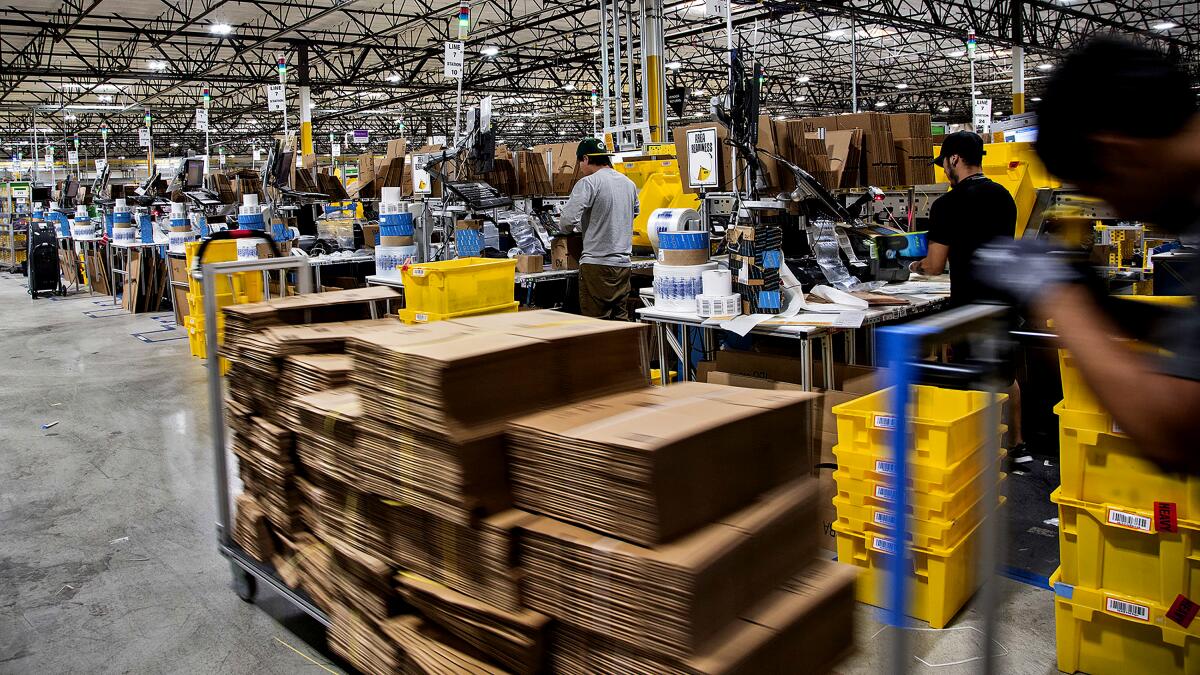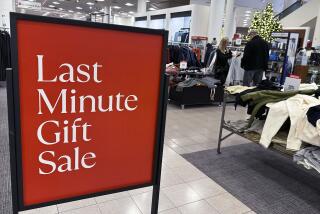Amazon Prime Day deals expected to disappoint as costs surge

- Share via
The deals during Amazon.com Inc.’s annual Prime Day sale will be stingier this year, according to merchants, thanks to rising shipping costs, higher advertising rates and scarce inventory.
The two-day event, which begins Monday, arrives as the world grapples with the lingering effects of the pandemic. Supply-chain disruptions — including the Suez Canal shutdown earlier this year and a spike in COVID-19 cases that has hobbled two of China’s busiest ports — have pushed up costs and made Amazon suppliers wary of selling too much during a profit-crushing sale. Many say they’re also holding back inventory in case shipping delays persist through the busy Christmas holiday shopping season.
“There’s growing deal fatigue on Amazon,” said Peter Darch, who manages inventory and supply chain at Perch, which owns a number of brands that are popular on Amazon. “We’re being a little more selective with deals.”
Amazon merchants, who account for 60% of sales on the website, are betting cash-rich consumers will overlook the more meager bargains and still swarm Prime Day. Online spending in the U.S. will hit an estimated $12.2 billion during the sale, with Amazon capturing 60%, according to EMarketer Inc. (Last year spending was $10.4 billion, but the pandemic pushed the sale back to October, making comparisons difficult.) As always, competing retailers are looking to surf the Prime Day wave. Walmart Inc.’s “Deals for Days” and Target Corp.’s “Deal Days” both began Sunday.
Amazon shares were down less than 1% at 11:45 a.m..
In a statement, a company spokesman said Amazon will offer more deals this year than last but didn’t mention the size of the discounts. “We continue to innovate and grow Prime Day to ensure our Prime members and selling partners find incredible value,” he said.
Amazon started Prime Day in 2015 to attract new subscribers who now pay as much as $119 a year for shipping discounts, video streaming and other perks. The event helps Amazon lock in shoppers before the holidays and deepen its relationship with existing customers by offering them deals on Amazon gadgets such as the Fire TV stick and smart speakers that run on the Alexa voice platform. Amazon brands will once again take center stage, with deals on surveillance doorbells from the company’s Ring division and a voice-activated Echo device for cars that will go for $15.
Ring provided at least 100 LAPD officers with free devices or discounts and encouraged them to endorse and recommend its doorbell and security cameras to police and members of the public.
Amazon, which has posted record profits this year, can afford to discount heavily. Many consumer-products companies don’t have that luxury and are thinking about raising prices as much as 10% this year, making it tough to participate in a big sale, said Shanton Wilcox, a partner at PA Consulting, whose clients include packaged-goods outfits confronting inventory shortages.
“Prime Day is going to be less exciting than it has been in the past,” he said. “You don’t want to scare away demand, but you have to manage profitability.”
Meanwhile, it’s becoming more expensive to buy search ads on Amazon, a necessity to stand out on the increasingly cluttered site. Advertising costs on Amazon spiked more than 50% in May compared with a year earlier, according to an analysis by Marketplace Pulse. While Amazon says merchants have control over how much they bid for keywords, search ads now account for about 30% of a product’s price, Marketplace Pulse says, up from about 20% a year ago. Surging advertising costs are just one more reason merchants are loath to offer deals.
“We are recommending that their discounts are softer on Prime Day,” said Brian Burt, who runs Canopy Management, an Austin, Texas, firm that provides consulting services to hundreds of Amazon merchants that generate more than $1 billion in annual sales on the site.
Amazon merchants are also grappling with tighter restrictions Amazon imposed this year on how much inventory they can push through its fulfillment centers. The company runs more efficiently when these facilities aren’t cluttered. But that pushes up shipping costs for merchants because they must send smaller loads more frequently.
After delaying Prime Day in 2020, Amazon this year moved the sale forward from its typical July slot to June — giving merchants only three weeks’ notice. Typically sellers like to place orders with factories several months in advance so the products can be shipped to the U.S. in time. The abrupt announcement means many merchants will have a more limited selection than they would with a longer lead time.
“Amazon just picks a date, which makes it very hard to plan, unlike a July 4 sale you can count on every year,” said Melissa Burdick, a former Amazon executive who is now president of Pacvue, an online marketing consulting firm. “So there’s not a lot of distinction or variation. You get a lot of Instant Pots and Bose headphones.”







